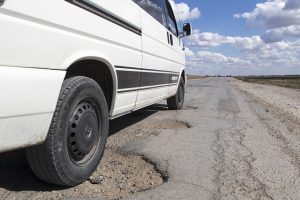
EcoGrit Ice Melt | Safe for Children and Pets, Any Surface | Non-Toxic Light-Weight Easy Application | Protects from Snow and Ice for up to a week.
EcoGrit provides a fantastic ice melt that is environment-friendly and pet-friendly
If you ask any group of motorists what their top irritations are when it comes to driving along the road, potholes and damage to the roads will come pretty high up the list for most, if not all of them. Potholes can damage a vehicle badly if someone drives into one without realising, as well as cause more serious problems with multiple pile-ups, traffic jams and gridlock on the roads.
 ated?
ated?Potholes are created when groundwater expands and contracts after it has seeped under the surface through porous material such as concrete or asphalt. The water expands as it freezes in sub-zero temperatures, taking up more space and forcing the surrounding material to bend and eventually crack to make room. The water then melts as temperatures rise above freezing, but the cracks and damage to the surface remain in place.
As this pattern repeats itself with changes to the temperature over subsequent days and nights, the surface becomes weaker and weaker until the cracks widen into full-blown, dangerous potholes. The situation is also not helped by heavy vehicles constantly driving over the top, adding more pressure to the compromised surface.
In sub-zero temperatures, potholes on the road are often accompanied by layers of snow or ice that has frozen to the surface, adding to the hazards faced by motorists and pedestrians trying to navigate safely.
As people try to clear the ice and snow using traditional de-icing methods like rock salt, the corrosive nature of the salt further damages the areas where there is cracking, making potholes larger, more dangerous and harder to repair. The rock salt alters the chemistry of the snow or ice, lowering the temperatures at which it freezes and speeding up the freeze-thaw cycle that is so damaging to pavements and roads.
The most obvious one of the many dangers of potholes to the driving public is the risk of driving into one, causing the vehicle to skid, swerve or come to an abrupt stop, damaging itself and posing a very real risk for people travelling behind it. Many road traffic accidents can be attributed to cracks and potholes in the road, especially in winter when there is less daylight and driving conditions are worsened by the presence of slippery snow, frost or black ice – which can be invisible until it is too late to react.
Likewise, on pavements and paths, the hazards of potholes and cracks can cause pedestrians, animals and cyclists to trip, fall and experience injuries during a normal outing. This can cause a distraction to pass motorists, who look to see what has happened or seek to pull over to try and help out.
In addition, badly maintained roads can often lead to traffic building up all around them as drivers are obliged to go slower as they work their way around a hazard like this. Traffic jams are not an uncommon consequence, which leads to impatience, frustration and higher chances of drivers taking dangerous risks to either circumnavigate the queue or make up for ‘lost time’ by speeding once they drive away from the blockage.

When a vehicle hits a pothole, the first point of contact and the area that will take the hardest impact is the tyres. Punctures are very common after hitting a pothole or crack due to the sharp areas inside the pothole or crack where the concrete or other materials used have ripped and are now sticking out at sharp, jagged angles.
Punctures can be immediately catastrophic, stopping the car instantly and requiring emergency roadside assistance, or they can be small but deadly, allowing air to hiss out almost undetected until the tyre goes flat and needs replacing. Either way, dangerous potholes are bad news for tyres.
One area that many motorists overlook when assessing their tyres for damage from a pothole is that the wheel alignment, or ‘tracking’, may have been damaged too. This is far costlier to fix and is very dangerous to leave unrepaired.
The jolt of a vehicle hitting a pothole, tyre first, can knock the angle and direction at which your tyres are set out of kilter, unbalancing the car and causing the tyres to wear unevenly. Signs that your wheel alignment is off include a sensation that the car is dragging or pulling to one side, vibrations through the steering wheel and squealing noises when you drive at low speeds.
A vehicle’s suspension comprises the shock absorbers, springs and links that connect it to its wheels and allow it to move. It also allows the driver and their passengers to have a smoother ride. As such, this area is especially vulnerable when it comes to pothole damage.
Just as the jolt of hitting a dangerous pothole can damage tyres and send wheels out of alignment, it can also seriously affect the suspension and make handling far harder. If you suspect that your vehicle’s suspension has been affected by hitting a pothole, crack in the road or kerb, it is vital that you get it checked as quickly as possible to prevent further damage or risk.

While the effects that potholes have on road and pavement surfaces and the vehicles and pedestrians that use them, there can be no doubt that the danger of potholes has a hugely adverse effect on the wider economy too. From a domestic budget point of view, people must pay for vehicle repairs, which can have a knock-on effect on motor insurance and the financial value of the affected vehicle when it comes to resale.
On a wider scale, the council in charge of road repairs must dig deeper into their budgets to pay for repairs and road resurfacing, which can impact provision in other service areas and civic amenities. Traffic jams also cause delays for people needing to get to the office, take children to school or make it on time to essential appointments.
This affects employee performance, pupil attendance records and accessibility to important appointments, medical or otherwise. Injuries can also lead to costly lawsuits and lengthy negotiations with law firms and solicitors over appropriate financial compensation and other legal matters following a pothole-related injury. Drivers stuck in jams will also need to buy more fuel than they would have done if the roads were all lovely and smooth with no queues to tackle along the way.
All of this leads to wasted money and a negative impact on the economy. The problems don’t simply stop as soon as a vehicle drives out of a pothole. Government councils, businesses and individuals must pay the price and always remain vigilant about the risk of potholes and the importance of choosing the right pothole solution.
Potholes in the road can cause a great deal of damage to cars and other vehicles. They can puncture tyres and ruin vehicles’ suspension and steering alignment. They can also cause scratched paintwork and marked bumpers from the impact of the car hitting the broken road. Driving into a pothole can also cause loss of control over the car, which can lead to accidents involving more than one vehicle. Protecting roads against winter weather, frost and ice is a key way to prevent potholes from happening. Use a naturally derived ice melt like EcoGrit to help protect road surfaces from corrosion and water ingress.
We may be heading into summer, but there is no time like the present to start thinking about how to protect key roads, pavements, driveways and other surfaces from dangerous potholes and cracks when the winter temperatures start to return.
Traditional methods of de-icing such as rock salt, are corrosive to surfaces, weakening them and expediting the forming of potholes. They can also cause serious harm to pets, local flora and fauna and ecosystems, as well as damage to people’s property and vehicles.
Switching to a gentler, non-corrosive alternative that still offers excellent de-icing properties and long-lasting results can help you clear unwanted ice and snow without putting surfaces at increased risk of potholes. Eco Grit Concentrate is environmentally friendly and easy to use. To find out about the many advantages of using EcoGrit Concentrate this winter, speak EcoGrit or visit the website today.
EcoGrit
20 Harbour View
Truro
Cornwall
TR1 1XJ

EcoGrit provides a fantastic ice melt that is environment-friendly and pet-friendly

With the return of winter and the inevitable widespread use of rock salt gritting, the RSPCA is warning to check pets’ paws and fur if






EcoGrit is an environmentally conscious company that would like to serve the people by offering them education, insight, “peace of mind” and the chance to make a positive difference on a monumental scale at a time when winter weather patterns are becoming more unpredictable.
VAT (Value Added Tax) Number: 340 3662 26
EcoGrit provides a fantastic ice melt that is environment-friendly and pet-friendly
© 2023 EcoGrit Ltd